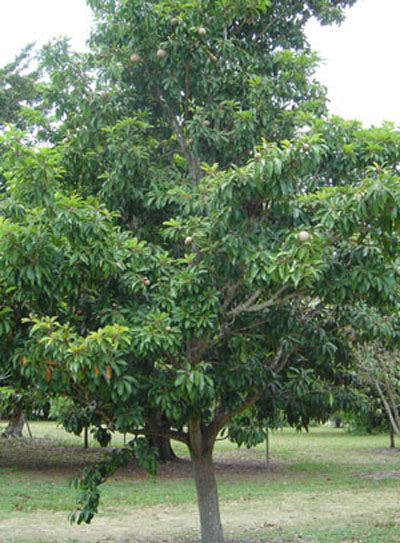- Chicle
Taxobox
name = Chicle

image_caption = "Manilkara chicle"
regnum =Plant ae
divisio = Magnoliophyta
classis =Magnoliopsida
ordo =Ericales
familia =Sapotaceae
genus = "Manilkara "
species = "M. chicle"
binomial = "Manilkara chicle"
binomial_authority = (Pittier) GillyChicle is the
natural gum from "Manilkara chicle", which is a tropical evergreen tree native toCentral America . The tree ranges fromVeracruz inMexico south to Atlántico inColombia . [ [http://www.ars-grin.gov/cgi-bin/npgs/html/taxon.pl?428790 Manilkara chicle information from NPGS/GRIN ] ] It was traditionally used inchewing gum . While theWrigley Company was a prominent user of this material, today there are only a few companies that still make chewing gum from natural chicle. This is because by the 1960s chicle was replaced bybutadiene -basedsynthetic rubber which was cheaper to manufacture.Chiclets are named after chicle.The name "chicle" comes from the
Nahuatl word for the gum, "tziktli" IPA| ['ʦikt͡ɬi] , which can be translated as "sticky stuff". Alternatively, "chichle" may have come from the Mayan word, "tsicte". [ [http://www.mexicolore.co.uk/index.php?one=azt&two=art&id=168 Mexicolore article on chicle] ] Chicle was well known to the Nahuatl-speakingAztecs and to the Maya (Amerindians), and early European settlers prized it for its subtle flavour and high sugar content.Locals who collect chicle are called "chicleros".
The tapping of the gum is similar to the tapping of
latex from therubber tree:zig-zag gashes are made in the tree trunk and the dripping gum is collected in small bags. It is then boiled until it reaches the correct thickness. Due to widespread tapping, the "Manilkara chicle" tree has become scarce and other sources like the relatedbalatá ("Manilkara bidentata") are increasing in use.Chicle is also a standard word for 'chewing gum' in Spanish. In Portuguese 'chiclete' may be used for a person who is known as a 'pest' or someone who will not leave another person alone.
References
Wikimedia Foundation. 2010.
